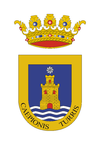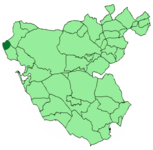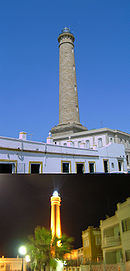Chipiona
| Chipiona municipality | ||
|---|---|---|
 Chipiona with lighthouse and sandstone church Virgen de Regla
|
||
| coat of arms | Map of Spain | |

|
|
|
| Basic data | ||
| Autonomous Community : | Andalusia | |
| Province : | Cadiz | |
| Coordinates | 36 ° 44 ′ N , 6 ° 26 ′ W | |
| Height : | 4 msnm | |
| Area : | 33 km² | |
| Residents : | 19,123 (Jan 1, 2019) | |
| Population density : | 579.48 inhabitants / km² | |
| Postal code : | 11550 | |
| Municipality number ( INE ): | 11016 | |
| administration | ||
| Mayor : | Antonio Peña Izquierdo ( PP ) | |
| Website : | www.aytochipiona.es | |
| Location of the municipality | ||

|
||
Chipiona is a small town in southern Spain. It belongs to the province of Cadiz in the Andalusia region and is located on the Atlantic Ocean at the mouth of the Guadalquivir . 19,123 residents live here (January 1, 2019), and in the summer tens of thousands of almost exclusively Spanish tourists “liven up” the town. It is best known for its large sandy beaches and the lighthouse. As a seaside resort, Chipiona serves many tourists as a starting point for trips to popular destinations such as Cádiz (city) (30 minutes by car), Jerez (30 minutes by car), Seville (90 minutes by car) and also Huelva (city) (about 90 minutes by car). Chipiona is considered to be one of the cleanest seaside resorts in Andalusia.
history
The name Chipiona comes from an ancient, no longer preserved lighthouse at the mouth of the Guadalquivir . It was founded by Quintus Servilius Caepio in 140 BC. Built in BC. Before that, numerous ships had crashed into the reef of the Piedra de Salmedina , one of the rocks off the coast. Roman finds on the city limits could be from the second century BC. To be dated.
Later the increased Chipionerische population was decimated by the attacks of the Visigoths . It took several centuries for her to slowly recover. Chipiona was conquered by the Moors for the first time in 711 . In 1251 it was bought by King Ferdinand III. conquered for the first time before his son Alfonso X finally won it for the Spanish Kingdom.
In 1295 King Sancho IV left “El Bravo” (The Brave) Chipiona to Alonso Pérez de Guzmán “El Bueno” (The Good), who built the small “city castle” that has been preserved to this day and later at the Conquista of Juan Ponce de León participated. Chipiona's further role in the story is modest. During the Spanish Civil War it was in the middle of the embattled south, to this day tensions can be seen between those who were communist and “ Franquists ”.
Attractions
The "Humilladero", the Holy María Vírgen der Regla
"María Virgen de Regla" ("Virgin María de Regla") is still the patron saint of the city. When the Arabs conquered Chipiona in the 8th century, hermits hid the icon in a water tank about 30 meters from the citadel , today's monastery. The statue of the Virgin Mary was rediscovered in the 14th century through an apparition of Mary . A so-called “humilladero” was built over the former water tank, a place of faith with the holy image of Mary and other religious symbols. It still stands next to the sandstone church “Vírgen de Regla”.
Cruz del Mar
In 1755 Chipiona was hit hard by the aftermath of the Lisbon earthquake . At the moment when the tidal wave was to hit Chipiona, according to legend, the Holy Christ of Mercy appeared and sent the wave back into the sea. A large iron cross, the "Cruz del Mar", was erected at this location. Even if we know today that the phenomenon actually took place and it can be scientifically proven, a procession to the popular lookout point is carried out from the town church on every first November of the year .
"Faro de Chipiona" lighthouse
The Chipionas lighthouse was built in 1867 and at 69 meters is the highest in Spain and one of the highest in the world. It is regarded as “the” symbol of the city. It is at the tip of a small headland called "Punta del Perro", the point of the dog . Like the ancient lighthouse ( history of Chipiona ), it still serves as a visual landmark for the cargo ships that enter the Guadalquivir River in large quantities .
Santuario de Nuestra Señora de Regla de Chipiona
The origin of the sanctuary lies in a fortress of the Ponce de León. In 1399 it was left to the Augustinian hermits , who stayed there until 1835. The square tower made of battlements of today's monastery is intended to remind of the original fort . In 1882 it was occupied by the Franciscans and converted into a school for missionaries for Morocco and the “Holy Land” . The sanctuary also includes the humilladero (see above), which contains the 62 cm high black Madonna Virgen de Regla , the city patroness of Chipiona (see story ).
economy
Chipiona's economy can be divided into four main sectors:
- Tourism: Chipiona is a very popular vacation spot among locals due to its large, bright, iodine-rich sandy beaches. Therefore the small town grows in the three summer months (June, July, August) to a small big town with approx. 120,000 inhabitants. The tourists are 90 percent Spanish and mostly from the surrounding provinces such as Seville or Huelva . Since the high level of government investment in the nearby holiday complex "La Ballena", Chipiona is slowly opening up to international tourism.
- Flowers: Chipiona is the main supplier of Spanish cut flowers, an important national and international flower exporter. However, with the noticeably worsening devastation of southern Spain and the adjustment to the climate of the nearby African north coast, the existence of more and more flower traders is threatened, in summer 2003 a water barrier was imposed in parts of Andalusia, many smaller traders had to give up due to extreme drought.
- Fish trade: along with agriculture, this is the oldest branch of the economy in the entire region, originally a large part of the population lived from selling fish. The fish from Chipiona and its "neighbor" Sanlúcar de Barrameda is known for its high quality.
- Wine: Moscatel , Oloroso and Vino Fino (both types of sherry ) and wine vinegar are produced in Chipiona and the surrounding area .
traffic
The bus station (estacion de autobuses) is located west of the city center on Avenida de Andalucia. There are bus connections to Seville (every hour between 6 a.m. and 8 p.m.), Jerez (6 times a day), El Puerto de Santa Maria / Cadiz (10 times a day), all connections via Sanlucar de Barrameda. Significantly fewer connections on weekends and on public holidays.
Population development
beaches
Chipiona has a large number of beaches, many of which have been awarded the Blue Flag for Europe's clean beaches:
- Playa de Regla
- Playa del Camarón
- Playa de las Tres Piedras
- Playa de la Ballena
- Cruz del Mar beach
- Playa de las Canteras
- Playa de Montijo
- Playa de la Laguna
Festivals and traditions
carnival
Carnival is Chipiona's greatest tradition and plays a major role throughout Andalusia. The carnival of the nearby city of Cádiz is well known . The first Chipioneric carnival dates back to the 1930s, and various parades (cabalgatas) and festive events are held between January and February to this day. The celebrations culminate in a national, huge festival on the last weekend in February. Especially on Friday this weekend there are around 150,000 people in disguise on the streets of Chipiona. People of all ages take part. In addition to the traditional celebratory speech, the “Pregón”, the traditional male comedy choirs, the “Chirigotas” and “Comparsas” also take part. In addition, eight “damas” (carnival “ladies” / princesses) are elected, one of which is chosen as the “Perla de Carnavales” (carnival “pearl” / queen). The damas with the pearl at the top then lead the impressive carnival parade on Carnival Sunday. A dynamic competition develops there between the individual participating groups, because here too prizes are awarded for the best ideas and implementation.
Romeria del Pinar
The Romería is a kind of pilgrimage from the town church to the forest chapel in the nearby pine forest (Pinar). A mile-long train of differently decorated carriages runs through the whole city, with a statue of Mary at the top. The well-dressed Spanish horses also play a special role. Originally strictly religious, the path into the forest has now turned into a huge party, where especially the young people take the opportunity to drink, celebrate and dance. The pilgrimage takes place between May and June, depending on the year.
Personalities from Chipiona
- Federico Oliver Crespo , writer
- Rocío Jurado (1946–2006), internationally successful singer
- José Antonio Castro Cebrián , writer
Personalities who worked in Chipiona
- Padre Lerchundi , priest and Arabist
- Peter Behnstedt , Arabist
Trivia
- The Spanish comedian and actor Juan Joya aka El Risitas appeared in 2007 on the show Ratones Coloraos - which was produced and hosted by Jesús Quintero - in which he reported on an entertaining job as a cook and dishwasher . Embedded in this is an incident when he deposited paella pans in the nearby sea of Chipiona in order to make his work easier through the action of the salt water, only to find out the next morning that the tide had washed away the pans. Joya and Quintero break out laughing again and again. The interview was uploaded to YouTube on June 25, 2007 and was viewed there more than a million times by the time it became internationally known.
- The novel The Changing Winds by Almudena Grandes is set mainly in Chipiona; although the place is not mentioned by name, this can be inferred from other names and distances.
literature
- C. Fernandez-Chicarro: CHIPIONA Cádiz, Spain . In: Richard Stillwell et al. a. (Ed.): The Princeton Encyclopedia of Classical Sites. Princeton University Press, Princeton NJ 1976, ISBN 0-691-03542-3 .
Web links
Footnotes
- ↑ Cifras oficiales de población resultantes de la revisión del Padrón municipal a 1 de enero . Population statistics from the Instituto Nacional de Estadística (population update).
- ↑ Strabo Geography 3,140; Appian Iberica 70
- ↑ Lighthouse coordinates: 36 ° 44 ′ 16.5 ″ N , 6 ° 26 ′ 32.2 ″ W




